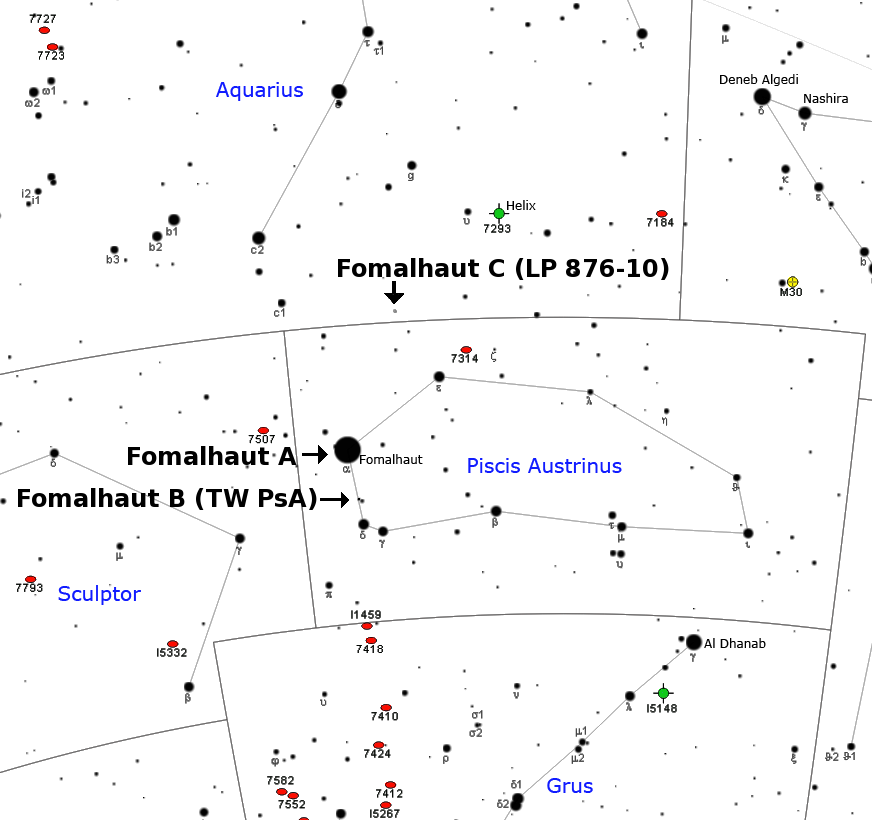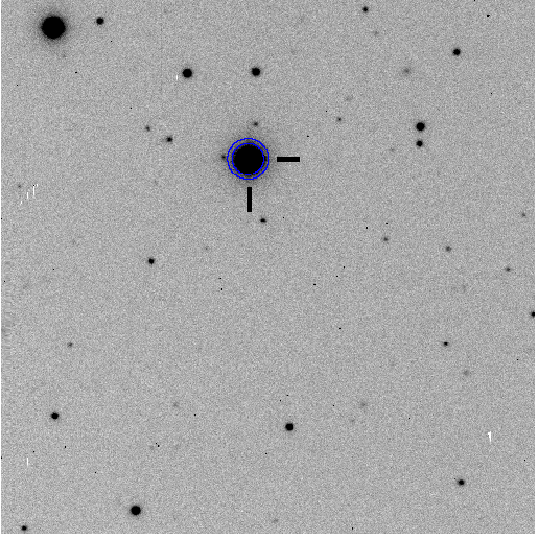Fomalhaut C = LP 876-10
"The Solar Neighborhood XXX. Fomalhaut C"
Mamajek, Bartlett, Seifahrt, Henry, Dieterich, Lurie, Kenworthy, Jao, Riedel, Subasavage, Winters, Finch, Ianna, & Bean (2013, AJ, 146, 154):
ArXiv/1310.0764 | Emulate ApJ Preprint | Published AJ Paper
SIMBAD entries for: Fomalhaut C (LP 876-10) |
Fomalhaut B (TW PsA) |
Fomalhaut A (Alpha PsA)
RECONS | SMARTS 0.9-m telescope | SMARTS | CTIO
See (1898) - claim of a companion to Fomalhaut which now appears to have been spurious
Luyten (1938) - first claim that TW PsA (Fomalhaut B) is a companion to Fomalhaut
Barrado y Navascues et al. (1997) - study of the age of Fomalhaut A & B
Mamajek (2012) - age of Fomalhaut system (~440 Myr), and demonstrating that TW PsA is likely a bound companion
Fomalhaut b planet candidate:
predicted to exist (Quillen 2006),
discovered (Kalas et al. 2008),
doubted (Janson et al. 2012),
yes its real (Currie et al. 2012),
yes its real (Galicher et al. 2013),
and here's some preliminary orbits (Kalas et al. 2013).
Fomalhaut appears numerous times in sci-fi novels(!)
Press:
UR press
release | ScienceShot
| Science
News | EarthSky
| phys.org
| Nature
World News | Science
Daily| Astronomy | Sky & Telescope
"Fomalhaut - A Crazy-Wide Triple Star": Sky & Telescope story 10/1/2014 by Bob King (way nicer graphics than what I have on this page!)

Map of the Fomalhaut triple system. Fomalhaut
C is roughly 6 degrees away from Fomalhaut A! Fomalhaut B is the
orangish K
dwarf TW
PsA (discussed
in Mamajek
2012). The age for this stellar trio appears to be consistent with
~440 million years. The arrows show the proper motion vectors for the
stars. Due to the relative motions between the Fomalhaut trio and our
Sun, the positions of the stars are all moving at approximately 0.4
arcseconds per year (taking about ~10,000 years to traverse a degree).

Map of the region around Fomalhaut
(constellations of Piscis Austrinus and Aquarius). Base map credited to Roberto Mura.

Finder chart for LP 876
(Fomalhaut C) - 6.8 arcminute field of view taken with SMARTS 0.9-m
telescope (V-band, taken in 2012). Star has V magnitude of 12.61, and
lies near 22:48:04.5 -24:22:08 (J2000). North is up, east is
left.

Astrometric residuals for LP 876-10 as measured
with respect to the best proper motion + parallax astrometric solution.
We find no evidence for astrometric perturbations due to any companions.
So thus far there is no evidence for a Fomalhaut "D" orbiting C.

V-K color vs. absolute magnitude (M_K) diagram
for Fomalhaut C showing empirical main sequences for M dwarf stars
(for solar and [Fe/H] = -0.1 metallicities from Johnson & Apps 2009)
and the Pleaides (Stauffer et al. 2007). Dotted lines are predicted
evolutionary tracks for low-mass stars are varying masses (0.10-0.20
Msun) and the long-dashed lines are isochrones for log(age/yr) = 8.1
(~120 Myr) and 8.6 (~400 Myr). Fomalhaut C is consistent with lying on
the observed main sequence for metallicity [Fe/H] ~ -0.07, which is
what is expected if it were ~440 Myr and had metallicity similar to
that measured for Fomalhaut B (TW PsA; [Fe/H] ~ -0.1).

Periodogram for a season of ASAS V-band
photometry for Fomalhaut C. The period measured near 0.45 days appears
to be real, while the other shorter periods are consistent with being
due to aliasing effects. Fomalhaut C is a fast-rotator, consistent
with its observed projected rotation speed measured spectroscopically
(vsini = 22 km/s).
How can LP 876-10 be a physical companion to Fomalhaut? Isn't it too far away?
We discuss this at length in
the paper
since it obviously seems kind of far compared to what we normally
think are typical separations for multiple stars. I'm not surprised
that there is skepticism to this claim because I originally thought it
might be too wide of a separation at first also! The 3D separation
between Fomalhaut A and C (LP 876-10) is 0.77 pc (2.51 light years,
159,000 AU). This is not calculated using the angular separation only,
as is often done. This is the actual 3-dimensional separation
between Fomalhaut A and C. The 3D separation can be calculated because
we have precise trigonometric parallaxes for both stars - from
Hipparcos for Fomalhaut A, and measured using the SMARTS 0.9-m
telescope on Cerro Tololo via the RECONS program for LP 876-10
(Fomalhaut C). As shown in the plot on the top of the page, the actual
3D separation between A and C is 158+2-1 kAU ("kilo-AU" = 1000
AU). Yes, the error bars are that small. Aren't precise trigonometric
parallaxes great?
In any case, as we discuss in the paper, it is straightforward
to calculate the "tidal radius" of the region where a star's gravity
dominates that of the Milky Way, and where a star can retain objects
in orbit without the Galaxy tearing them away. This is somewhat
analagous to the "Hill radius" calculated for planets in our solar
system - where all the natural satellites/moons of the planets have
been discovered within ~70% of the Hill radius of their planets. The
"tidal radius" (see equation 2 in the paper) works out to be
about 1.35 pc times the total mass of the system to the 1/3 power.
For Fomalhaut A itself, the tidal radius works out to 1.7 pc!
Hence, Fomalhaut C (LP 876-10) lies well within (0.8 pc) this
theoretical tidal radius.
It is true that stellar companions are most often within about ~0.1 pc
of their star. Examples at larger radii were rare (see the nice
discussion in Caballero
2009), however more
recently Shaya
& Olling 2011 have shown that companions at ~parsec-scale
separations may be much more common than previously recognized
(although some of their "binaries" appear to simply be pairs of stars
in previously known clusters, e.g. Ursa Major, the Tucana nucleus,
etc.).
In our paper, we show that Fomalhaut A and C are statistically
consistent with having similar motions at the ~1 km/s level. More
precise radial velocities of both Fomalhaut A and C will help
determine just how closely their velocities match. The predicted
orbital velocity of Fomalhaut C around the Fomalhaut AB pair is only
~0.15 km/s or so, and the escape velocity is only ~0.2 km/s. We note
that the system is young
(~440 million years), so
it seems plausible that this fragile multiple system has survived ~2
Galactic rotations without having Fomalhaut B or C perturbed by
neighboring stars beyond the tidal radius of Fomalhaut A.
In the paper we also argue that it seems very unlikely that we are
witnessing Fomalhaut C "escaping" the Fomalhaut system right now. The
chances of us capturing the system during a ejection (that might take
millions of years) are statistically very tiny. We also argue that the
stellar group that Fomalhaut was claimed to belong to (The Castor
Moving Group) probably doesn't exist. More precisely, we show that
some of the more prominant members (e.g. Vega, Castor, Fomalhaut, LP
944-20) of the purported group do not appear to have orbits consistent
with a common origin. I would go further and argue that the Castor
Moving Group (as it is currently used in the literature) is an
extremely unhelpful human construct, and that the continuing
use of this group in the literature by some astronomers has only given
false hope to other unwitting astronomers that we can use membership
to the group to assign ages to group "members" (stellar ages are
notoriously difficult to determine accurately, and for some
astrophysical research accurate ages for young stars are especially
valuable). But if the "members" of Castor Moving Group have
well-determined space motions consistent with showing that they
do not show a past common origin (as we do in our paper), and
if their mutual gravity is too feeble to keep the group together, then
what good is the group other than a possible example of a "dynamical
stream" (a group of otherwise unrelated stars whose orbits are focused
to a small region of velocity space due to perturbations by the
Galactic gravitational potential - i.e. either the bar, or spiral
arms)? Anyway, I have not seen any strong evidence that Fomalhaut is
immersed within a stream of truly comoving (kilometer per second)
stars to which Fomalhaut C might belong. I created a catalog a few
years back of stellar velocities of ~30,000 nearby stars with measured
parallaxes, proper motions, and radial velocities. I was surprised to
see that the star with the 3D space velocity most similar to Fomalhaut
was.... Fomalhaut B (TW PsA). Within 100 pc of the Sun, among these
~30,000 stars, not a single other star with measured velocity had a
velocity within 2 km/s of that of Fomalhaut. So if there is a stream
of other Fomalhaut "siblings", they must be dominated by low-mass
stars and not have been bright enough to both appear in the Hipparcos
catalog and have a previous radial velocity measurement. Given the
proximity of Fomalhaut C within the tidal radius of Fomalhaut A (and
both A and B together), I would say that the preponderance of
evidence is on the side of Fomalhaut C being a physical companion to
Fomalhaut A and B, and not some "fellow traveler".





